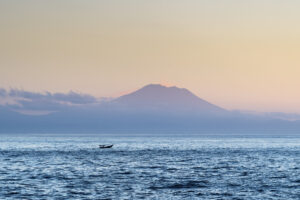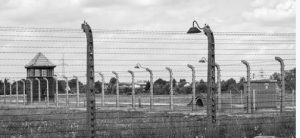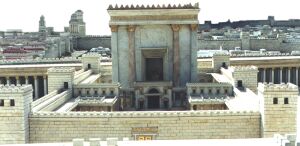Was It The Finger?
By Dr. Mori Bank
Lt.Col. Zeev Raz, squadron leader of the Israeli Air Force’s 1981 attack on
As Raz related details of the dramatic mission, conducted just before Shavuos; the examples of hashgacha pratis came in such rapid succession that one could imagine his story being told word for word by a Maggid. Though he gave over the facts in a dry matter of fact manner, as if he were debriefing his commanders after the mission, at one point he had to admit, “If I were a believer I would say that this “mission’s success” was the Hand of G-d.”
Harav Baruch Horowitz, Rosh Yeshivas ‘Dvar Yerushalayim’ and the program organizer, set the tone for the meeting. Just before the Osiraq attack, the Prime Minister Menachem Begin, zt’’l sent a representative to Rav Eliezer Menashem Mann Shach, zt”l, asking that the Ponovezh Rosh Yeshivah, zt’’l, pray for Am Yisroel who were again facing an imminent threat of another holocaust, this time atomic.
Begin was a man who was not shy about quoting verses of faith,” said Rav Horowitz,relating an episode he had heard from Begin’s personal adviser, Yehudah Avner:
“Avner was present at a meeting between U.S. President Jimmy Carter, Egyptian Premier Anwar Sadat and Begin, in which President Carter told Begin, “You have to give over territories to the Palestinians, because if you don’t, you’ll lose the support of the
The attack on Osirak was carried out under the leadership of this man of faith, a prime minister who believed in the ultimate salvation of
In the mid-s 70s
Diplomatic pressure was applied on
By 1981, it was clear that the reactor would soon become radioactive, after which time an attack on it would cause catastrophic results similar to
The clock was ticking, but how could they strike at a target so far away, beyond the range of the F-16’s? Raz recalls that he gave the assignment to Ilan Ramon zt’’l, who would later become
But even with the problems of political backing and range of the planes addressed, other factors were still compelling against carrying out the attack.
“According to Ilan’s projections, the Iraqis would have us in their sights for 15 minutes, even if we took the best route under the best conditions, they would have 15 minutes to respond to our entry into their air space. For an air force fighter pilot 15 minutes is like eternity. Even if they didn’t spot us right away and even if their air space systems took time, their planes could reach us easily and they wouldn’t even have to down us – all they would have to do was circle overhead and force us to engage them, which would destroy our plans.
This is why we set out with eight pilots, which was more than we needed, plus an escort of two F-15’s to engage the Iraqis if necessary – we wanted to make sure that at least some of us would get through and bomb the reactor.
Raz recalls his argument with officers in air force planning, who insisted that the attack be launched after sunset, in order to give the IAF a full night to conduct search-and-rescue missions if a pilot was downed.
“I argued that we needed to carry out the attack before sunset. Maybe there’d be poor visibility or enemy planes, and we would need light. It was a unique situation, one that is usually reversed. The planners in Tel Aviv, who themselves were in no danger, had uppermost in their minds the safety of the crew, whereas the ones actually carrying out the mission were most concerned about the mission’s success.”
Raz reminisced about the scene on the tarmac before takeoff. “Raful flew in to be with us. He was sitting shivah for his son, but he flew in and spoke to us like a father. He said ‘If you get caught, tell them everything you know, don’t worry about any secrets! Rather just come back alive.’ Then he gave each of us some home-grown dates and joked with us, ‘Here. . . enjoy these in the Iraqi jails.’ Psychologically, this sort of approach works. It gives the soldiers the sense that they’re already dead, so they might as well give it their all in the mission.”
While on the tarmac, the pilots received Iraqi currency, in case they had to bail out over enemy territory. “I told Raful that this was crazy. If I land in the desert, what I need is water, and if I’m in
“So we set out from the Etzion Airbase in Eastern Sinai, and then turned and flew across the Red Sea into
What no one had taken into account, however, was that a most highly placed source had spotted them, and was making an urgent effort to alert Saddam Hussein.
King Hussein of
“We successfully jettisoned the empty fuel tanks over
“On our way back no attempts were made to intercept us, no missiles, no radars and no planes, but we saw something that Israeli air force pilots are not accustomed to. I had never seen such a thing – we flew into the sunset, and at our speed, we saw the sun as if it didn’t move for the whole 45 minute journey. Maybe an airline pilot is used to this, but in
“We arrived back at the Etzion airbase just before sunset erev Shavuot and were brought in for debriefing. The officers all wanted to hear our report on the operation, particularly about difficulties that arose so that they could try to make improvements. No one had anything to add, as everything had gone so smoothly. The planes had performed so perfectly, as if they had a neshama, and knew the gravity of the mission: to avert a holocaust.
“Then one of the men put it into words – ‘it was the finger of G-d.'”
If any further proof of this was needed, they saw it the following day, as Raz related: “For the mission, all the planes had worked perfectly, the whole way there and back. None of the pilots reported even the most minor, typical malfunction, but the day after these same planes began having all the typical malfunctions.”
The finger of G-d was needed on the diplomatic front as well.
“It was not Jimmy Carter but Ronald Reagan, the hawk of hawks, who was
“Any time you make a preemptive strike, you don’t know what will happen. As for
Some of those who objected to the attack on Osiraq claimed that all we would do back then is slow down the process. They argued, if you delay development of nuclear weapons by three years, is it worth it? We argued back then that it wouldn’t be three years but seven, and no one imagined back then that Saddam Hussein would attack
Today, the challenge is 55 times greater, and with world support it appears possibly 70 times worse. Iran had learned the lesson of Osiraq only too well, and is carrying out its nuclear program at 55 different sites in cities throughout the country, in well fortified locations 20 stories underground, too deep even for a bunker buster to have its affects. Imagine the civilian casualties and the world response. Therefore, “an air strike is unrealistic,” explains Raz. “This could only cause damage, not stop the process. Stopping the Iranians could only be done by bringing in ground forces by a world coalition, as was done in the Gulf War” which seems highly unlikely today.
Author of the book “First Strike,” Shlomo Nakdimon noted, while not minimizing the danger, “there exists today what can be called an unwritten agreement between
Raz feels that in the present situation, the Iranians will succeed in developing nuclear weapons of mass destruction. Coupled with their long range missile program., this means that we are in need of Hashem’s salvation now, more than any of us can ever imagine.
This brought the meeting to a conclusion, and Rav Horowitz offered a mashal for our task in these terribly dangerous times: “This globe is like a spacecraft, and we are the pilots of this spacecraft. To be a pilot means a lot of self-discipline. You can dabble in aeronautics, but one’s concentration must be given fully to the rules and how to put them into practice, fulfilling all of the instructions worked out by engineering teams of the highest caliber, and one must put all his confidence into what they said.
“…We have been given the task of saving mankind. We are the pilots and must look out for all the passengers on this spacecraft, and the way we do it is to keep our faith alive, and share it with those not yet educated in faith. This faith is critical for the survival of the nation, not just spiritually but also physically, and not just for our nation but the whole of mankind. And if from this evening we can get a bit of courage to spread the word, that whatever these maniacs say or do, the power of our G-d is greater than any of them!
“This is the deep significance of the fact that this event, the strike against Osiraq coincides with the greatest event of Jewish History – Matan Torah and Shavuot – which brought the People of Israel in direct contact with the Creator to bring about salvation to the world.”
In conclusion, at the debriefing, one pilot felt it was the finger of Ha-shem. Lt. Col. Zev Raz, the commander of the mission, claimed it was the hand of Ha-shem. As we recall each year in the hagaddah, “Rabbi Yosie, Haglili, said: “How can you infer that the Egyptians were afflicted with ten plagues in
Was it the Finger or was it the Hand? The clue may exist in Devarim 32:11. Metaphorically, Ha-shem is like an eagle hovering over its young, carrying Am Yisroel on His wings.






